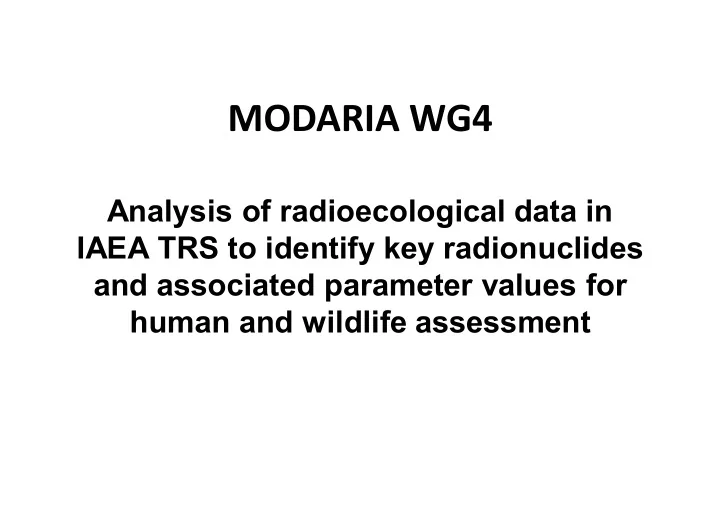

MODARIA MODARIA WG4 Analysis of radioecological data in IAEA TRS to identify key radionuclides and associated parameter values for human and wildlife assessment
IAEA Parameter value compilations
Objectives Using the recent data compilations: • Identify data gaps which matter • Provide guidance on need for further data for different source terms • Explore ways to make TRS data more usable by modelling community • Consider both human and wildlife
Meeting issues • New info on parameter values, analysis of transfer values and current sampling • Isotopes in Source terms Collate list of relevant isotopes • Which are important / unimportant re dose • What is quality and quantity of available data in TRS / site • • Derivation of Screening values Focus on SRS19 update, soil-plant, plant-animal • Revised TRS plant-animal DB • Derivation of missing values • • A common Kd database for terrestrial, freshwater, marine Document use of Kd in assessments for different source • terms Common DB structure • Updates DB (ongoing) •
New info / sampling Red: Range and GM (TRS479) 100 Japan 10 1 CR wo-soil Norway 0.1 0.01 0.001 0.0001 Wild boar Asian black bear Sika deer Japanese pheasant Animals USA Amchitka S. Korea
Source term information • U mining • Weapons testing sites • Regulated releases Reprocessing • power plants • Land disposal • arsenals •
GRNC: Groupe Radioécologie Nord Cotentin
U mining - 238 U-series rads Wildlife organism doses • 226 Ra and 210 Po most important • Most important exposure pathway is internal • Lower soil EMCLs in desert compared with tropical climate Public doses animal-based - Po-210 (93%) • plant-based - Po-210 (45%), Pb-210 (36%), Ra-226 (16%) • Po-210 (88%) – overall diet •
Test sites - wildlife
Screening assessments • TRS 472 where possible • 75 percentile, if n≥10 Soil-plant • Crops – Grain, Potato, Rice; Forage - Grasses • “all” soils TRS 472 category • > 50 values - Am, Cd, Ce, Cm, Co, Cs, Ni, Np, Pb, Pm, Pu, Ra, Ru, Sb, Sr, Th, U, Zn • Analogue approach and using stable isotopes as support for expert judgments of ratios between elements • Comparison between NCRP 123 and TRS 472 max values where < 10
Cow milk – revised TRS database Fm and CR vs Fa Fractional absorption 1.E+00 0.00 0.20 0.40 0.60 0.80 1.00 1.E-01 Fm cow milk 1.E-02 1.E-03 R² = 0.6422 4.0E-1 1.E-04 3.5E-1 3.0E-1 1.E-05 CR cow milk R² = 0.8264 2.5E-1 1.E-06 2.0E-1 1.5E-1 1.0E-1 5.0E-2 0.0E+0 0 0.2 0.4 0.6 0.8 1 1.2 Fractional absorption Supported by TREE project of RATE – funded by NERC, RWM and EA in UK
Plant – animal, SRS vs update
Kd activities • Kd data and analysis reported by participants Impact of simplification of processes • Discussed database template
MODARIA – WG4 - Kd Kd Issues • High uncertainty (several orders) • Concerns several transfer pathways • Conservatisms are not obvious • Many gaps (data and reference values) Needs • Fill gaps • Reduce uncertainty Objectives • Recommendation for using Kd • Update soils and freshwater Kd databases • Define a generic structure of Kd databases • Develop uniforms databases for soils, freshwater and marine environments • Perform cross analysis (media, elements, components, co-factors) • Specify Kd impact on different transfer models 11/19/2014 MODARIA – WG4 - Kd 14
Global Generic Structure Definition & Model Use Isotope Value & Statistics Sorption Protocol Kd Reference Experimental Approach Sample Solution Solid Reference For each item: define a generic list of relevant parameters for Kd in soils, freshwater and marine 11/19/2014 MODARIA – WG4 - Kd 15
MODARIA report • What is Kd and how it is used in different source terms & models • Technical document presenting a generic structure for Kd databases • Examples of updated soils and freshwater Kd compilation CDFs • Template of Excel file to enable contributors to input Kd data Proposals for next « MODARIA » • Development of soils, freshwater and marine databases (Access Software) • Transfer of existing compilations into these databases • Update and complete reference values • Cross analysis (multi-media, multi-elements, multi-components, co- factors) to fill some gaps • Specified Kd impacts on transfer models and consider application 11/19/2014 MODARIA – WG4 - Kd 16
� GM values and data variability (range of values) may vary significantly according to the factors used to group the data, � “intelligent” database should be able to provide parameter values (e.g., GM; ranges of values according to percentiles) according to pre-established filters better accommodate end-user requirements decrease data variability. � Filters could be applied in parallel or sequentially, if adequate data available. Example: K d (Cs) in soils GM min max 5th 95th GM min max 5th 95th Global data set 1135 6 650000 35 40700 Global data set 1135 6 650000 35 40700 Sand group 350 6 65400 15 7100 RIP/Kss < 100 80 10 715 11 470 Clay group 6700 565 375000 560 81200 RIP/Kss > 10000 9700 220 375000 1050 89100
2015 Interim meetings • Key dose formers for different source terms and screening assessment parameter values – With MODARIA WG8 – Vienna April • Kd – IAEA Monaco weeks of 13 th April – Involving WG4 participants and some organisations who have Kd databases or who utilise them
Recommend
More recommend